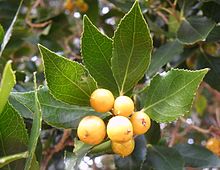
Curtisia dentata is a flowering tree from Southern Africa. It is the sole species in genus Curtisia, which was originally classed as a type of "dogwood" (Cornaceae), but is now placed in its own unique family Curtisiaceae.

Protea is a genus of South African flowering plants, also called sugarbushes. It is the type genus of the Proteaceae family.

Leucospermum is a genus of evergreen upright, sometimes creeping shrubs that is assigned to the Proteaceae, with currently forty-eight known species.

Kirstenbosch is an important botanical garden nestled at the eastern foot of Table Mountain in Cape Town. The garden is one of 10 National Botanical Gardens covering five of South Africa's six different biomes and administered by the South African National Biodiversity Institute (SANBI). Prior to 1 September 2004, the institute was known as the National Botanical Institute.
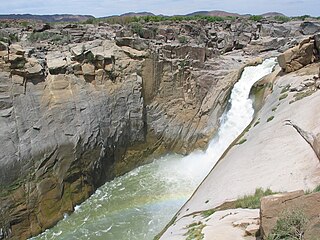
Augrabies Falls National Park is a national park located around the Augrabies Falls, about 120 km west of Upington in the Northern Cape Province, South Africa.

Newlands Cricket Ground is a cricket venue in Newlands, Cape Town. One of the oldest sporting stadiums in South Africa, the ground is owned by the Western Province Cricket Association (WPCA) and is the home of Western Province and MI Cape Town.

Nature's Valley is a holiday resort and small village on the Garden Route along the southern Cape coast of South Africa. Nature's Valley lies between the Salt River, the foothills of the Tsitsikamma Mountains, the Indian Ocean and the Groot River lagoon. Nature's Valley has a balmy climate and is surrounded by the de Vasselot Nature Reserve which is part of the Tsitsikamma Park, and in turn part of the Garden Route National Park.

The wildlife of South Africa consists of the flora and fauna of this country in southern Africa. The country has a range of different habitat types and an ecologically rich and diverse wildlife, vascular plants being particularly abundant, many of them endemic to the country. There are few forested areas, much savanna grassland, semi-arid Karoo vegetation and the fynbos of the Cape Floristic Region. Famed for its national parks and big game, 297 species of mammal have been recorded in South Africa, as well as 849 species of bird and over 20,000 species of vascular plants.

Scolopia is an Old World genus of plants in the family Salicaceae.
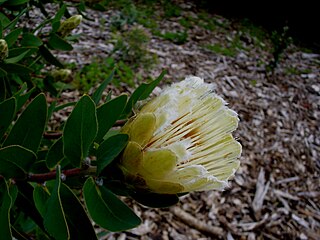
Protea mundii, the forest sugarbush, is a flowering shrub native to the Cape Provinces of South Africa, growing in forest margins at 200 to 1,300 m elevation. It grows to a height of 8 m (26 ft). The plant has white to ivory flowers, which are attractive to bees, butterflies and/or birds. The specific name commemorates Johannes Ludwig Leopold Mund, a German natural history collector who was active in the Cape until 1831.
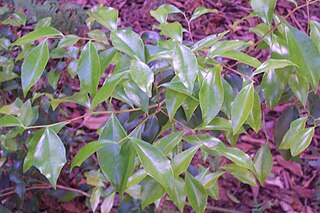
Scolopia braunii is an Australian rainforest tree. Common names for this species include flintwood, mountain cherry, brown birch and scolopia. The habitat is Australian coastal rainforests of various types.
Thaminophyllum is a genus of South African plants in the chamomile tribe within the daisy family. It is endemic to the Cape Provinces.

Brabejum is a genus of a single species of large evergreen tree, Brabejum stellatifolium in the family Proteaceae, commonly called wild almond, bitter almond or ghoeboontjie. It is restricted in the wild to South Africa's Western Cape province, where it grows in thickets along the banks of streams. The plant is of botanical interest as being Africa's only member of the large grevilleoid subfamily. It is a bushy small tree with branches widely at ground level and numerous erect vigorous stems. Leaves grow up to 6 in (15 cm) long, narrow and bluntly toothed, appear at intervals along the branches, mostly in whorls of 6. In summer, the plant bears white flowers densely crowded on spikes arising from rusty buds at the leaf axils. The fruits to 2 in (5 cm) long, magenta to reddish brown, similar to an almond, appear in autumn. The nut is too bitter to eat; however, in earlier times it was boiled, roasted, and ground to make a "coffee" drink.
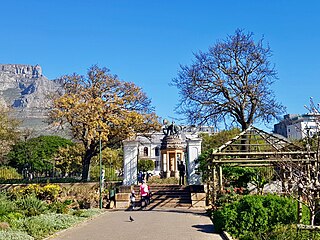
The Company's Garden is the oldest garden in South Africa, a park and heritage site located in central Cape Town. The garden was originally created in the 1650s by the region's first European settlers and provided fertile ground to grow fresh produce to replenish ships rounding the Cape. It is watered from the Molteno Dam, which uses water from the springs on the lower slopes of Table Mountain.

Southern Afrotemperate Forest is a kind of tall, shady, multilayered indigenous South African forest. This is the main forest-type in the south-western part of South Africa, naturally extending from the Cape Peninsula in the west, as far as Port Elizabeth in the east. In this range, it usually occurs in small forest pockets, surrounded by fynbos vegetation.

Cecilia is a section of the Table Mountain National Park on the lower eastern slopes of Table Mountain in Cape Town, located just to the south of Kirstenbosch National Botanical Garden. It was previously used for commercial logging and known as Cecilia Forest or Cecilia Plantation, but has now been given protected status and integrated into the National Park.
Johannes Ludwig Leopold Mund (1791-1831) and Louis Maire were natural history collectors who worked in the Cape Colony under the sponsorship of the Berlin Museum of Natural History. Museum specimens they collected were always labeled under the names, "Mund & Maire".
Henry George Flanagan was a Cape Colony-born plant collector, traveller, botanist and farmer. He developed a renowned garden for native South African trees and rare exotic plants. A rare endemic of Eastern Cape, Greyia flanaganii is one of several plants named in his honour.

Leucospermum mundii is an evergreen, upright, rounded and richly branching shrub of ½–1 m (1½–3 ft) high that is assigned to the family Proteaceae. It has greyish, felty hairy, or hairless leaves that are broadly wedge-shaped to very broadly inverted egg-shaped, 5–8½ cm long and 2–6½ cm wide and whorl-shaped flower heads that have shades of pale yellow to crimson, of 2–4 cm (0.8–1.6 in) long and 1–2 cm (0.4–0.8 in) wide that grow in clusters of three to ten. Their long styles that emerge from the head jointly give the impression of a pincushion, with the pins upright. It is called Langeberg pincushion in English. Flowering heads can be found between July and November. It naturally occurs in fynbos in the Western Cape province of South Africa.
